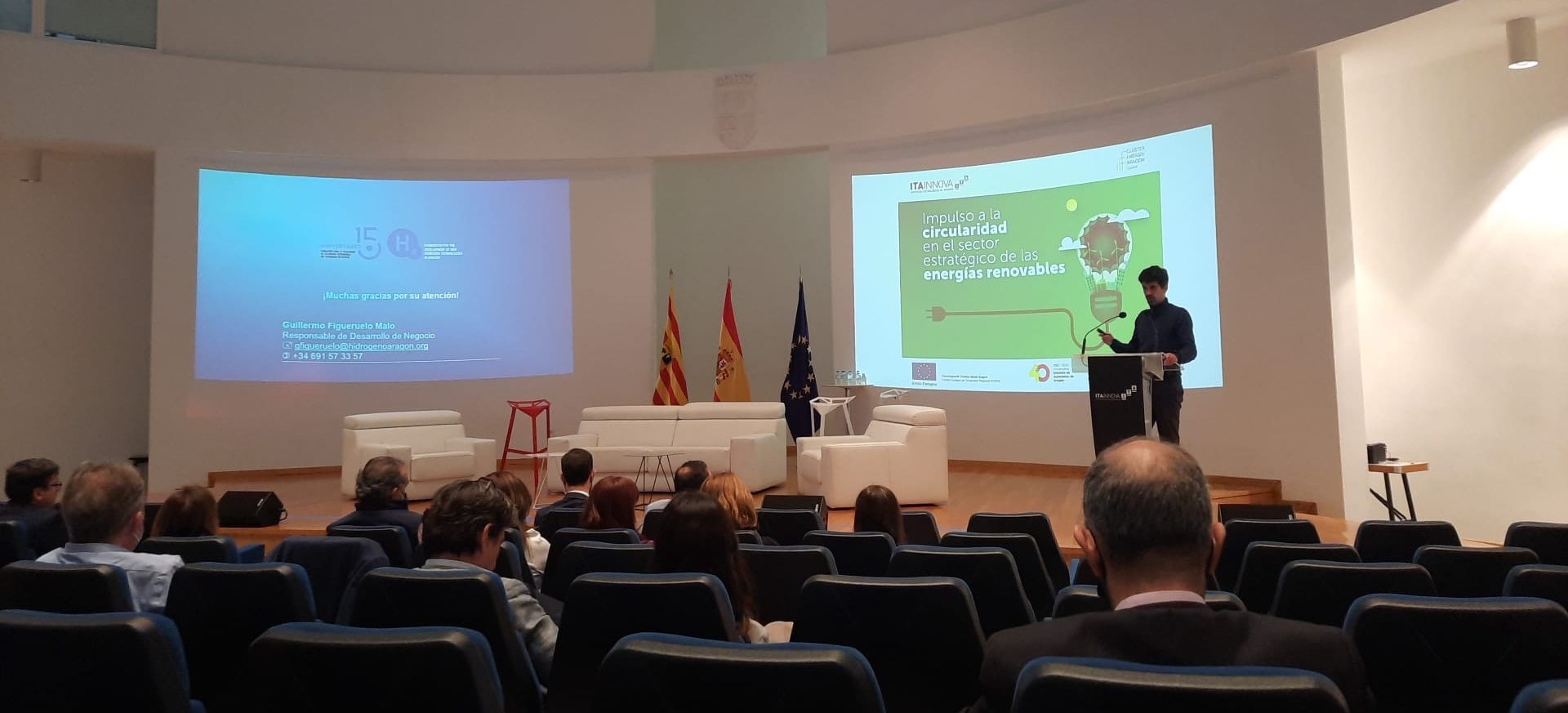Together with CLENAR, we participated in the conference held at ITAINNOVA
Together with CLENAR, we participated in the conference held at ITAINNOVA to promote circularity in renewables.
The aim of the conference was to publicise and highlight the projects and initiatives of the Aragonese ecosystem aimed at creating a more sustainable and circular energy system. In addition, the contribution to the promotion of new initiatives and possibilities for collaboration. The projects that have been shown can serve as an example for new initiatives, and the conference has served as an opportunity to seek possibilities for collaboration in the Aragonese ecosystem.
Esther Borao, director of ITAINNOVA and representative of the entity on the Foundation’s Board of Trustees, welcomed the nearly 60 attendees and invited the participants to continue collaborating on future public and private projects.
Miguel Luis Lapeña, Director General of Planning and Economic Development of the Government of Aragon, presented the Aragonese Circular Economy Strategy. In this sense, he remarked that “Aragón Circular aims to promote the transition to the circular economy in Aragón, supporting this emerging economic sector for its consolidation as a strategic sector in our autonomous community”.
He also referred to the “Aragón Circular Seal”, which is a distinctive public recognition of companies, local administrations and entities in general of their commitment to the circular economy model, the performance of good practices and actions to improve their circularity, within the framework of an excellent, innovative and sustainable management, which meet the established requirements, in addition to strict compliance with current legal obligations.
The conference included presentations on Research and Development (R&D) projects carried out at the Engineering Research Institute of Aragon (I3A) of the University of Zaragoza, “Development of a biomass valorisation process with negative CO2 emissions”, by Javier Ábrego; “Recycling and sustainability in hydrogen and fuel cell technologies”. We would like to highlight the presentation by our colleague Guillermo Figueruelo, Head of Business Development at the Foundation on: “Circular technologies and strategies in the renewable energy sector”. In addition, Carmen Bartolomé, CIRCE Foundation, also a member of the Board of Trustees of the Foundation, gave the presentation; and “Durability and eco-design in turbine blades for wind and tidal power”, by Ana Martínez Santamaría, from ITAINNOVA.
Dr. Ana Martínez, from Business Development at ITAINNOVA, presented two projects (NEMMO and CARBO4POWER) on durability and eco-design in turbine blades for marine energy, including both off-shore wind and tidal energy.
Ana Martínez stressed the role of composite materials in this technology. The development of lighter, stronger, multi-functional and modular multi-material solutions allows for increased performance and durability, reducing cost and environmental impact at the same time.
ITAINNOVA’s extensive experience in advanced materials simulation has enabled them to provide support in the design and selection of materials, in manufacturing processes and in predicting the durability of equipment.
One of the main difficulties of circularity in multi-materials is the correct separation of the different components. ITAINNOVA is working on the development of adhesive materials with on-demand disassembly properties that provide sufficient strength during use and allow the different parts to be separated for correct recycling.
Sustainability, recycling and circular economy in companies were also addressed. Examples of sustainable actions in Viñas del Vero were presented by José María Ayuso, from González Byass; the photovoltaic recycling research study, by Jesús Alijarde, from Ibersyd; the circular economy in the food industry, by Luis Viscasillas Torrero, from Grupo Jorge; the circular economy in biomass energy generation plants, by Francisco Soria, from Forestalia; and storage and circular economy in a decarbonised electricity sector, by Fernando Sebastián, from Atalaya Generación.
On behalf of Forestalia, the engineer Francisco Soria presented various aspects related to the circular economy in the electricity generation plant using agroforestry biomass located in Cubillos del Sil (León).
Francisco Soria pointed out three aspects of circular economy, related to the water cycle, the capture and reuse of CO2, and the research for the valorisation of the ash generated in the combustion, through its application in the improvement of elements of other products, such as fertilisers or materials for the construction sector.
Forestalia’s plant is equipped for the combustion of both forest biomass and straw, with different storage, processing and boiler feed systems for both types of fuel, which incorporates greater technical complexity.
Practically all of the fuel comes from forestry waste generated in the clearing of forests, which in itself is also an example of the revalorisation of waste, in addition to the advantages provided in the prevention of forest fires.
For his part, the general manager of Íber Sostenibilidad y Desarrollo (IBERSYD), Jesús Alijarde, presented the research project on the integral recycling of solar panels promoted by his company. Alijarde recalled that this objective is an opportunity for the future since, according to a report by the Renewable Energy Agency (Irena), it is estimated that in 2050 there will be 78 million tonnes of waste with which 4,000 million solar panels could be built.
To achieve this, the BERSYD group has promoted its company CERFO (European Photovoltaic Recycling Centre) and has undertaken a research project together with the CIRCE technology centre. The aim of this project, which has institutional support from the Department of Economy of the Government of Aragon for the promotion of the circular economy, is to achieve maximum recycling with high quality materials, following thermal, chemical or thermochemical processes.
In this way, CERFO seeks to promote the total circularity of materials in the European photovoltaic market, so that it is economically viable. It also aims to position Aragon as a strategic centre for photovoltaic recycling and attract productive industry to the region.
The closing speech was given by Pedro Machín, president of CLENAR, who highlighted the interest of this conference and how fruitful it will be due to the synergies that can be established. “Aragon is ready for the transition to the energy system of the future”, he concluded.
This dissemination activity is co-financed by the European Regional Development Fund in the framework of the Aragon ERDF Operational Programme 2014-2020.



